[JEE Mains MCQs]
Q1: A student determined Young's Modulus of elasticity using the formula  The value of g is taken to be 9.8 m/s2, without any significant error, his observation are as following.
The value of g is taken to be 9.8 m/s2, without any significant error, his observation are as following.
 Then the fractional error in the measurement of Y is :
Then the fractional error in the measurement of Y is :
(a) 0.0083
(b) 0.0155
(c) 0.155
(d) 0.083
Ans: (b)
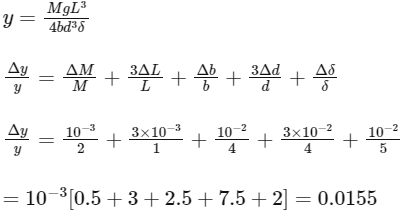
Q2: If velocity [V], time [T] and force [F] are chosen as the base quantities, the dimensions of the mass will be :
(a) [FT − 1 V−1]
(b) [FTV − 1]
(c) [FT2 V]
(d) [FVT − 1]
Ans: (b)
[M] = K[F]a [T]b [V]c
[M1] = [M1L1T−2]a [T1]b [L1T−1]c
a = 1, b = 1, c = − 1
∴ [M] = [FTV − 1]
Q3: Match List - I with List - II.
 Choose the most appropriate answer from the option given below :
Choose the most appropriate answer from the option given below :
(a) (a)-(iii), (b)-(i), (c)-(iv), (d)-(ii)
(b) (a)-(ii), (b)-(i), (c)-(iv), (d)-(iii)
(c) (a)-(i), (b)-(iii), (c)-(iv), (d)-(ii)
(d) (a)-(iii), (b)-(iv), (c)-(i), (d)-(ii)
Ans: (a)
torque τ → ML2T−2 (iii)
Impulse I ⇒ MLT−1 (i)
Tension force ⇒ MLT−2 (iv)
Surface tension ⇒ MT−2 (ii)
Q3: Which of the following equations is dimensionally incorrect?
Where t = time, h = height, s = surface tension, θ = angle, ρ = density, a, r = radius, g = acceleration due to gravity, v = volume, p = pressure, W = work done, T = torque, ∈ = permittivity, E = electric field, J = current density, L = length.
(a) 
(b) 
(c) 
(d) W = τθ
Ans: (a)
(a)  = dv/dt = Volumetric flow rate (Poiseuille's law)
= dv/dt = Volumetric flow rate (Poiseuille's law)
(b) 
(c) 

LHS

(d) W = τθ
Q4: Match List - I with List - II.

Choose the most appropriate answer from the options given below :
(a) (a)-(ii), (b)-(iii), (c)-(iv), (d)-(i)
(b) (a)-(iii), (b)-(ii), (c)-(iv), (d)-(i)
(c) (a)-(iv), (b)-(ii), (c)-(i), (d)-(iii)
(d) (a)-(iii), (b)-(ii), (c)-(i), (d)-(iv)
Ans: (b)
SI unit of Rydberg const. = m−1
SI unit of Plank's const. = kg m2s−1
SI unit of Magnetic field energy density = kg m−1s−2
SI unit of coeff. of viscosity = kg m−1s−1
Q5: If force (F), length (L) and time (T) are taken as the fundamental quantities. Then what will be the dimension of density :
(a) [FL−4T2]
(b) [FL−3T2]
(c) [FL−5T2]
(d) [FL−3T3]
Ans: (a)
Density = [FaLbTc]
[ML− 3] = [MaLa+bT−2aLbTc]
[M1L−3] = [MaLa+bT − 2a+c]

So, density = [F1L−4T2]
Q6: Which of the following is not a dimensionless quantity?
(a) Relative magnetic permeability (μr)
(b) Power factor
(c) Permeability of free space (μ0)
(d) Quality factor
Ans: (c)

[power factor (cos ϕ)] = 1

[μ0] = [MLT−2A−2]

So Q is unitless & dimensionless.
Q7: If E and H represents the intensity of electric field and magnetising field respectively, then the unit of E/H will be : A ohm B mho C joule D newton
(a) ohm
(b) mho
(c) joule
(d) newton
Ans: (a)

Q8: Match List - I with List - II
 Choose the most appropriate answer from the options given below :
Choose the most appropriate answer from the options given below :
(a) (a)-(ii), (b)-(iv), (c)-(i), (d)-(iii)
(b) (a)-(ii), (b)-(i), (c)-(iv), (d)-(iii)
(c) (a)-(iii), (b)-(ii), (c)-(iv), (d)-(i)
(d) (a)-(iii), (b)-(i), (c)-(iv), (d)-(ii)
Ans: (d)
(a) Magnetic Induction = MT−2A−1
(b) Magnetic Flux = ML2T−2A−1
(c) Magnetic Permeability = MLT−2A−2
(d) Magnetization = M0L−1A
Q9: If the length of the pendulum in pendulum clock increases by 0.1%, then the error in time per day is :
(a) 86.4 s
(b) 4.32 s
(c) 43.2 s
(d) 8.64 s
Ans: (c)
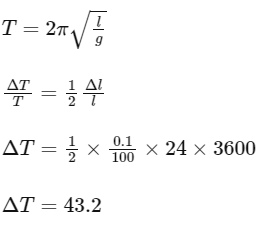
Q10: In a Screw Gauge, fifth division of the circular scale coincides with the reference line when the ratchet is closed. There are 50 divisions on the circular scale, and the main scale moves by 0.5 mm on a complete rotation. For a particular observation the reading on the main scale is 5 mm and the 20th division of the circular scale coincides with reference line. Calculate the true reading.
(a) 5.00 mm
(b) 5.25 mm
(c) 5.15 mm
(d) 5.20 mm
Ans: (c)
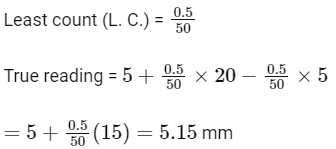
Q11: If E, L, M and G denote the quantities as energy, angular momentum, mass and constant of gravitation respectively, then the dimensions of P in the formula P = EL2M−5G−2 are :
(a) [M0 L1 T0]
(b) [M −1 L−1 T2]
(c) [M1 L1 T−2]
(d) [M0 L0 T0]
Ans: (d)
E = ML2T−2
L = ML2T−1
m = M
G = M − 1L+3T−2


Q12: A physical quantity 'y' is represented by the formula 
If the percentage errors found in y, m, r, l and g are 18, 1, 0.5, 4 and p respectively, then find the value of x and p.
(a) 5 and ± 2
(b) 4 and ± 3
(c) 16/3 and ± 3/2
(d) 8 and ± 2
Ans: (c)


⇒ 8 = xp
By checking from options.

Q13: Assertion A: If in five complete rotations of the circular scale, the distance travelled on main scale of the screw gauge is 5 mm and there are 50 total divisions on circular scale, then least count is 0.001 cm.
Reason R: 
In the light of the above statements, choose the most appropriate answer from the options given below : (a) A is not correct but R is correct.
(b) Both A and R are correct and R is the correct explanation of A.
(c) A is correct but R is not correct.
(d) Both A and R are correct and R is NOT the correct explanation of A.
Ans: (a)

In 5 revolution, distance travel, 5 mm
In 1 revolution, it will travel 1 mm.
So least count = 1/50 = 0.02
Q14: The force is given in terms of time t and displacement x by the equation
F = A cos Bx + C sin Dt
The dimensional formula of AD/B is :
(a) [M0 LT−1]
(b) [ML2T−3]
(c) [M1L1T−2]
(d) [M2 L2 T−3]
Ans: (b)
[A] = [MLT−2]
[B]=[L−1]
[D]=[T−1]
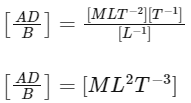
Q15: If time (t), velocity (v), and angular momentum (l) are taken as the fundamental units. Then the dimension of mass (m) in terms of t, v and l is :
(a) [t−1 v1 l−2]
(b) [t1 v2 l−1]
(c) [t−2 v−1 l1]
(d) [t−1 v−2 l1]
Ans: (d)

comparing powers
c = 1, b = − 2, a = − 1
m ∝ t-1 v-2l1
Q16: The vernier scale used for measurement has a positive zero error of 0.2 mm. If while taking a measurement it was noted that '0' on the vernier scale lies between 8.5 cm and 8.6 cm, vernier coincidence is 6, then the correct value of measurement is ___________ cm. (least count = 0.01 cm)
(a) 8.58 cm
(b) 8.54 cm
(c) 8.56 cm
(d) 8.36 cm
Ans: (b)
Reading = MSR + VSD × LC − zero error

Q17: In order to determine the Young's Modulus of a wire of radius 0.2 cm (measured using a scale of least count = 0.001 cm) and length 1m (measured using a scale of least count = 1 mm), a weight of mass 1 kg (measured using a scale of least count = 1 g) was hanged to get the elongation of 0.5 cm (measured using a scale of least count 0.001 cm). What will be the fractional error in the value of Young's Modulus determined by this experiment?
(a) 0.14%
(b) 9%
(c) 1.4%
(d) 0.9%
Ans: (c)
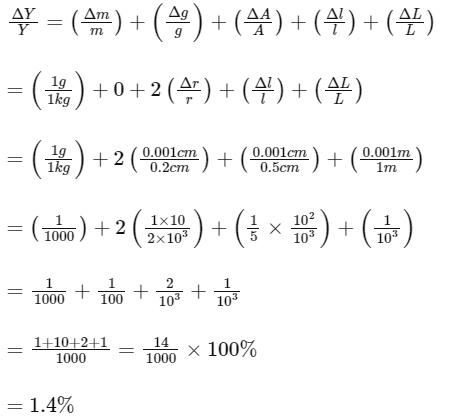
Q18: One main scale division of a vernier callipers is 'a' cm and nth division of the vernier scale coincide with (n − 1)th division of the main scale. The least count of the callipers in mm is:
(a) 10a/n
(b) 
(c) 
(d) 
Ans: (a)
n VSD = (n − 1) MSD

L.C. = 1 MSD − 1 VSD


= MSD/n
= a/n cm
= 10a/n mm
Q19: If 'C' and 'V' represent capacity and voltage respectively then what are the dimensions of λ where C/V = λ ?
(a) [M−3 L−4 I3 T7]
(b) [M−2 L−3 I2 T6]
(c) [M−2 L−4 I3 T7]
(d) [M−1 L−3 I−2 T−7]
Ans: (c)
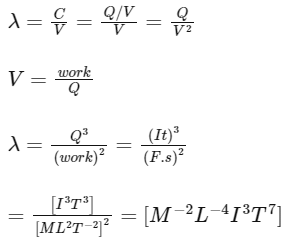
Q20: In a typical combustion engine the workdone by a gas molecule is given by  , where x is the displacement, k is the Boltzmann constant and T is the temperature. If α and β are constants, dimensions of α will be :
, where x is the displacement, k is the Boltzmann constant and T is the temperature. If α and β are constants, dimensions of α will be :
(a) [M0LT0]
(b) [MLT−1]
(c) [MLT−2]
(d) [M2LT−2]
Ans: (a)
kT has dimension of energy
 is dimensionless
is dimensionless
[β] [L2] = [ML2 T−2]
[β ] = [ MT−2]
α2 β has dimensions of work
[α2] [MT−2] = [ML2 T−2]
[α] = [M0LT0]
Q21: If e is the electronic charge, c is the speed of light in free space and h is Planck's constant, the quantity  has dimensions of :
has dimensions of :
(a) [MLT−1]
(b) [MLT0]
(c) [M0 L0 T0]
(d) [LC−1]
Ans: (c)
Given
e = electronic charge
c = speed of light in free space
h = Planck's constant
We know, E = hc/λ


= dimensionless
= [M0 L0 T0]
Q22: Match List - I with List - II:
 Choose the correct answer from the options given below :
Choose the correct answer from the options given below :
(a) (a) → (ii), (b) → (iii), (c) → (iv), (d) → (i)
(b) (a) → (i), (b) → (ii), (c) → (iv), (d) → (iii)
(c) (a) → (iii), (b) → (ii), (c) → (iv), (d) → (i)
(d) (a) → (iii), (b) → (iv), (c) → (ii), (d) → (i)
Ans: (a)
Kinetic Energy,

Momentum, mv = [MLT−1]
Plank constant :
E = γ
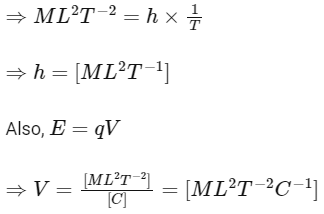
Q23: The pitch of the screw gauge is 1 mm and there are 100 divisions on the circular scale. When nothing is put in between the jaws, the zero of the circular scale lies 8 divisions below the reference line. When a wire is placed between the jaws, the first linear scale division is clearly visible while 72nd division on circular scale coincides with the reference line. The radius of the wire is :
(a) 1.80 mm
(b) 0.90 mm
(c) 0.82 mm
(d) 1.64 mm
Ans: (c)
Least count = 1mm/100 = 0.01 mm
zero error = + 8 × LC = + 0.08 mm
True reading (Diameter)
= (1 mm + 72 × LC) − (Zero error)
= (1 mm + 72 × 0.01 mm) − 0.08 mm
= 1.72 mm − 0.08 mm
= 1.64 mm
Therefore, radius = 1.64/2 = 0.82 mm.
Q24: The work done by a gas molecule in an isolated system is given by,  where x is the displacement, k is the Boltzmann constant and T is the temperature. α and β are constants. Then the dimensions of β will be:
where x is the displacement, k is the Boltzmann constant and T is the temperature. α and β are constants. Then the dimensions of β will be:
(a) [M0 LT0]
(b) [M L2T-2]
(c) [M LT-2]
(d) [M2 LT2]
Ans: (c)
Where, k is Boltzmann constant,
T is temperature and x is displacement.
We know that,  is a dimensionless quantity.
is a dimensionless quantity.


Since, dimensions of k are [k] = [M1 L2 T−2 K − 1 ] ...... (ii)
Dimensions of temperature are [T] = [K] ..... (iii)
Substituting Eqs. (ii) and (iii) in Eq. (i), we get

[α] = [M−1 T2]
According to dimensional analysis,
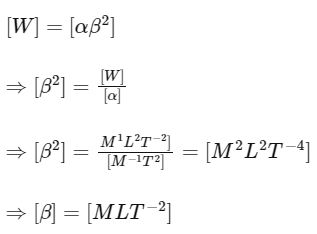
[JEE Mains Numericals]
Q25: The diameter of a spherical bob is measured using a vernier callipers. 9 divisions of the main scale, in the vernier callipers, are equal to 10 divisions of vernier scale. One main scale division is 1 mm. The main scale reading is 10 mm and 8th division of vernier scale was found to coincide exactly with one of the main scale division. If the given vernier callipers has positive zero error of 0.04 cm, then the radius of the bob is ___________ × 10−2 cm.
Ans: 52
9 MSD = 10 VSD
9 × 1 mm = 10 VSD
∴ 1 VSD = 0.9 mm
LC = 1 MSD − 1 VSD = 0.1 mm
Reading = MSR + VSR × LC
10 + 8 × 0.1 = 10.8 mm
Actual reading = 10.8 − 0.4 = 10.4 mm
radius = d/2 = 10.4/2 = 5.2 mm
= 52 × 10 − 2 cm
Q26: The acceleration due to gravity is found upto an accuracy of 4% on a planet. The energy supplied to a simple pendulum to known mass 'm' to undertake oscillations of time period T is being estimated. If time period is measured to an accuracy of 3%, the accuracy to which E is known as ________%
Ans: 14
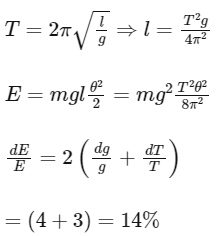
Q27: Student A and student B used two screw gauges of equal pitch and 100 equal circular divisions to measure the radius of a given wire. The actual value of the radius of the wire is 0.322 cm. The absolute value of the difference between the final circular scale readings observed by the students A and B is ______________.
[Figure shows position of reference 'O' when jaws of screw gauge are closed]
Given pitch = 0.1 cm.
 Ans: 13
Ans: 13
For (A)
Reading = MSR + CSR + Error
0.322 = 0.300 + CSR + 5 × LC
0.322 = 0.300 + CSR + 0.005
CSR = 0.017
For (B)
Reading = MSR + CSR + Error
0.322 = 0.200 + CSR + 0.092
CSR = 0.030
Difference = 0.030 − 0.017 = 0.013 cm
Division on circular scale 
Q28: Three students S1, S2 and S3 perform an experiment for determining the acceleration due to gravity (g) using a simple pendulum. They use different lengths of pendulum and record time for different number of oscillations. The observations are as shown in the table.
 (Least count of length = 0.1 cm and Least count for time = 0.1 s)
(Least count of length = 0.1 cm and Least count for time = 0.1 s)
If E1, E2 and E3 are the percentage errors in 'g' for students 1, 2 and 3 respectively, then the minimum percentage error is obtained by student no. ______________.
Ans: 1
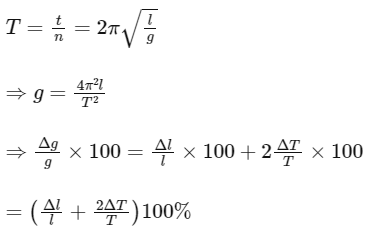
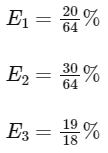
Q29: The radius of a sphere is measured to be (7.50 ± 0.85) cm. Suppose the percentage error in its volume is x.
The value of x, to the nearest x, is __________.
Ans: 34
Given, radius of sphere = (7.50 ± 0.85) cm
∴ r = 7.50 and dr = 0.85
We know, volume of a sphere 
taking log both sides, we get

Differentiating both sides,

∴ Fractional error in volume 
∴ % error in volume,
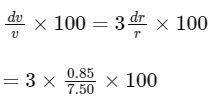
= 34%
Q30: The resistance R = V/I , where V = (50 ± 2)V and I = (20 ± 0.2)A. The percentage error in R is 'x'%. The value of 'x' to the nearest integer is _________.
Ans: 5
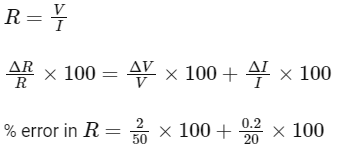
% error in R = 4 + 1
∴ % error in R = 5%
 The value of g is taken to be 9.8 m/s2, without any significant error, his observation are as following.
The value of g is taken to be 9.8 m/s2, without any significant error, his observation are as following. Then the fractional error in the measurement of Y is :
Then the fractional error in the measurement of Y is :
 Choose the most appropriate answer from the option given below :
Choose the most appropriate answer from the option given below : 


 = dv/dt = Volumetric flow rate (Poiseuille's law)
= dv/dt = Volumetric flow rate (Poiseuille's law)









 Choose the most appropriate answer from the options given below :
Choose the most appropriate answer from the options given below :




















 , where x is the displacement, k is the Boltzmann constant and T is the temperature. If α and β are constants, dimensions of α will be :
, where x is the displacement, k is the Boltzmann constant and T is the temperature. If α and β are constants, dimensions of α will be : is dimensionless
is dimensionless has dimensions of :
has dimensions of :

 Choose the correct answer from the options given below :
Choose the correct answer from the options given below :

 where x is the displacement, k is the Boltzmann constant and T is the temperature. α and β are constants. Then the dimensions of β will be:
where x is the displacement, k is the Boltzmann constant and T is the temperature. α and β are constants. Then the dimensions of β will be: is a dimensionless quantity.
is a dimensionless quantity.




 Ans: 13
Ans: 13
 (Least count of length = 0.1 cm and Least count for time = 0.1 s)
(Least count of length = 0.1 cm and Least count for time = 0.1 s)





































